British Special Service Squadron - April 1924
- View news filtered by: Interwar
- View news filtered by: Navy Organisation
- View news filtered by: Specialisms
- View news filtered by: Units & Squadrons
- View news filtered by type: Blog
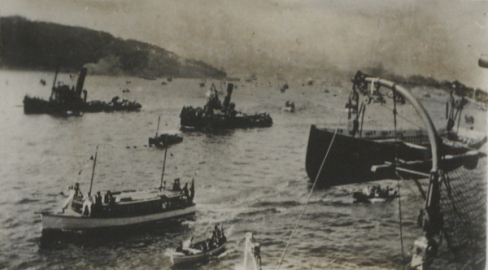
In this ongoing blog series, the National Museum of the Royal Navy is following the route of the British Special Service Squadron during the centenary of its voyage. In this entry we discuss their travels to Tasmania and New South Wales, Australia.
As the Squadron had readied for departure from Melbourne on 25 March 1924, the second fatality of the cruise occurred. Alfred Punshon, a Commissioned Signal Boatswain with HMS Hood had fallen ill and passed away in hospital in Melbourne. He was buried in Melbourne General Cemetery, and his gravestone put up by the kindness of the Royal Australian Navy.
Hobart, Tasmania 27 March – 3 April 1924
"Thursday morning dawned in a nasty mist and drizzle... we came to anchor quite close to the pier [at Hobart]... it was a miserable morning, which may have accounted for the absence of anything like a welcome... After Melbourne it was so noticeable." RNM 1999/31. Wilfred Woolman, 27 March 1924.
Hobart, described as a beautiful port, is located up the river Derwent in the south-east of Tasmania. It was large enough to accommodate all the ships and had a temperate climate which the crews found familiar. Captain Round-Turner wrote:
"Monday 31st. We have had nothing but rain here since we arrived, until today. It is all quite different from the rest of Australia... There are quite a number of entertainments but all quite simple ones." Captain Charles Round-Turner.
Indeed, the Squadron had a full programme of events, despite the weather.
The following extract from the programme of events at Hobart shows just how many functions had been planned over six days:
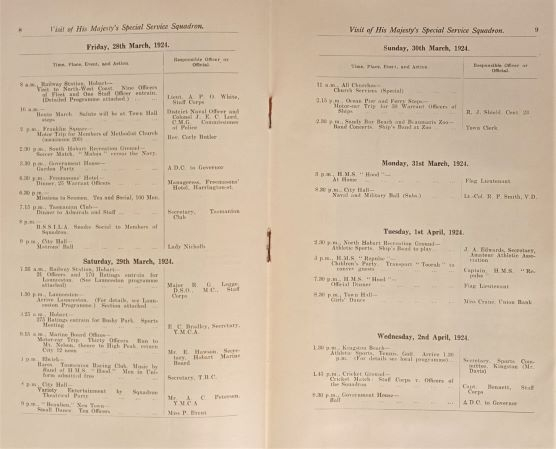
One of these was a Children’s Party which was held on board HMS Repulse. The event included:
"a rocking ladder, a wooden and a canvas shute, [slides] and a flip flap [seesaw]… the grown-ups were simply amazed to find such things on board, many of them confessed they thought the children would be bored for three hours on board the ship." RNM 1999/31. Wilfred Woolman
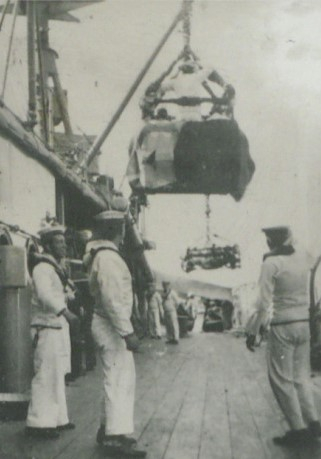
While these official duties and soft social diplomacy were attended to, the ordinary daily routines of running the ship and life on board still had to be kept up. Inspections and regular maintenance of equipment were important to minimise problems out at sea. Also, cleaning and polishing, or brightwork stations, was done not only to keep the ship looking nice, but to encourage the crew to have a sense of pride in their ship. 11am was ‘Up Spirits’, or the time the tot of rum issued to the sailors in the Royal Navy daily was given out, the custom only ceasing in 1970.
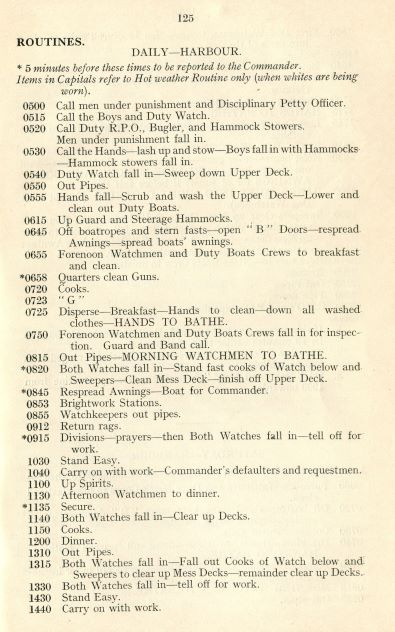
The squadron left Hobart on 3 April 1924. Despite the drizzle, a small crowd was there to see them leave. Most of the Squadron then took a slow trip including a few hours anchored in Twofold Bay. Meanwhile, HMS Dauntless steamed on directly for Sydney, pausing to help a merchant ship in distress, the Japanese Honolulu Maru which had been caught in a storm. HMS Dragon later relieved HMS Dauntless continuing aid to Honolulu Maru. The squadron then anchored in Jervis Bay, New South Wales 5-8 April for three days of rest before their arrival in Sydney.
Sydney, New South Wales - 9 April 1924
At 10am, 9 April 1924 the squadron passed through the Sydney Heads towards Sydney Harbour and were greeted by residents in small boats who had come out to see their arrival.
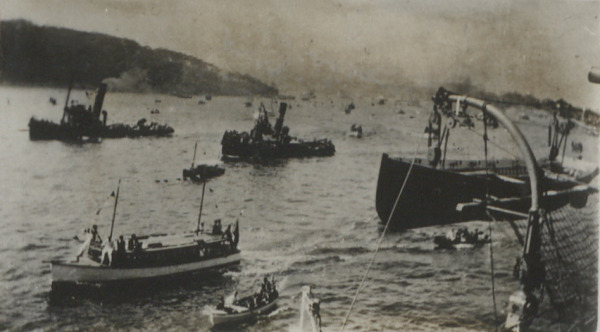
In addition to the welcome parades and official functions, the squadron was to gain a new ship, HMAS Adelaide, joining the cruise at Sydney. The Australian cruiser was to accompany the British ships on the next stage, up to Canada. This had been offered as a training experience to the Australian Navy and to demonstrate to Canada the naval developments in Australia; the British hoping this would encourage Canada to spend more on naval affairs and warships. Naval defence of the Empire was promoted as consisting of two elements, local defence which each territory could provide and general defence, a wider provision of naval power consisting of capital ships from Britain.
The British Empire had gained several additional territorial responsibilities following of the break-up of Germany's colonies after the First World War; it was expected by the British Government these should be defended if they were attacked, despite limitations placed on the Admiralty by the Treasury Department. The dominions were encouraged to pay for their own navies, and Australia created a Naval Construction Trust Account in the Defence Equipment Act, passed in August 1924.
The Squadron separated at Sydney. The Light Cruiser Squadron leaving Saturday 12 April 1924 to visit Brisbane and various ports in the South Island. They were also to witness the sinking of HMAS Australia outside the Sydney Heads under the terms of the Washington Naval Treaty of 1922. The treaty placed restrictions on the number of ships in the navies of the British Empire, United States, France, Italy, and Japan, and since Australia was part of the British Empire forces it needed to reduce its number of ships. The ship had served as part of the Grand Fleet in the North Sea during the First World War and the Australian nation was dismayed at it having to be sunk.
"Sentimental memories were awakened as the helpless hulk of what was once the pride of the Australian navy was manoeuvred into position by the tugs in preparation of her last passage. Floral tributes from the sorrowing country flooded the foredeck and mounted to the bridge" Unnamed columnist - Western Argus, 15 April 1924
Charles Round-Turner of HMS Dauntless recalled the military ceremony more succinctly:
"we steamed passed in two divisions, hoisted the Australian ensign at half-mast and the Delhi fired a salute of 21 guns." Captain Charles Round-Turner
The Special Service Squadron was focussed on the issues of future defence requirements, rather than the past. After the Light Cruisers arrived at Brisbane there were the customary ceremonies on which Captain Round-Turner also remarked:
"‘We are in the midst of a terrible official day… They have given us as usual a wonderful welcome… but in the speeches, the Labour Government don't disguise the fact that they believe that there will never be another war & therefore ships & especially new cruisers are unnecessary & provocative. They say “we will all fight for the old country and the empire if the time ever comes", which of course is useless if you have no trained men or weapons to fight with.’ RNM 2015/175/4. Captain Charles Round-Turner
The visit then ended as the previous month had done and was also marred by the death of a crew member, William Harrhy of HMS Dauntless, who drowned in Brisbane River on 18 April 1924. A dance was arranged on board, to help raise funds for his family at home.
The Light Cruisers returned to Sydney on 23 April 1924 for a further three days. Their next destination was Dunedin (New Zealand, South Island). The battlecruisers, HMS Hood and HMS Repulse accompanied by HMAS Adelaide, had instead already left for Wellington, New Zealand on 20 April 1924.
Come back next month to hear about the next leg of the squadron’s journey.
In the meantime, if you want to learn more about the British Special Service Squadron you can search our Collection.
Sources and further reading
Grenfell, Russell. A cruiser commander's orders. Gieves, c1930. - 135p
Harrington, Ralph 'The Mighty Hood': Navy, Empire, War at Sea and the British National Imagination, 1920-60 Author(s): Source: Journal of Contemporary History, Apr. 2003, Vol. 38, No. 2 (p. 171-185
Hurd, Archibald, The Empire Cruise, Unity of the seas published in The Argus (Melbourne, Vic. : 1848 - 1957) Sat 5 Jan 1924 Page 4
Mitcham, John C. The 1924 Empire Cruise and the Imagining of an Imperial Community. Britain and the World, March 2019, vo. 12, No. 1 : pp. 67-88
Family papers of Vice Admiral Murray Pippon, KBE (Private collection)
Lieutenant C.R. Benstead, an officer aboard Hood who published his account of the cruise as Around the World with the Battle Cruisers in 1924
RNM 2015/175/4 Letters of Captain Charles Round-Turner to his wife. 1923-1924
RNM 1999/31 Woolman, Wilfred. Typescript transcription of a diary kept by Wilfred as Schoolmaster in HMS Repulse during the world cruise of the Special Service Squadron, 27th November 1923 - 29th September 1924. Transcript by his son Aubrey Woolman
Scott O'Connor, Vincent Clarence. The Empire Cruise. Riddle, Smith & Duffus, 1925
Tracy, N. Collective Naval Defence of the Empire, 1900-1940. Navy Records Society. Vol 136. 1997
Vivian, John GP (Commander RN). Royal United Service Institution (RUSI) Journal 9 December 1925 p312
Western Argus Sinking of HMAS Australia (Kalgoorlie, WA : 1916 - 1938) Tue 15 Apr 1924, page 3. Accessed 10 April 2024